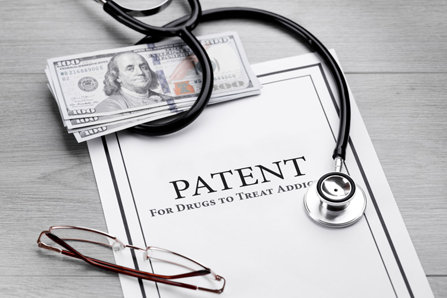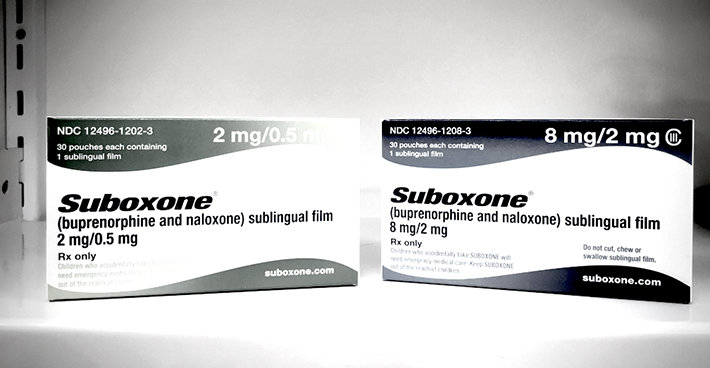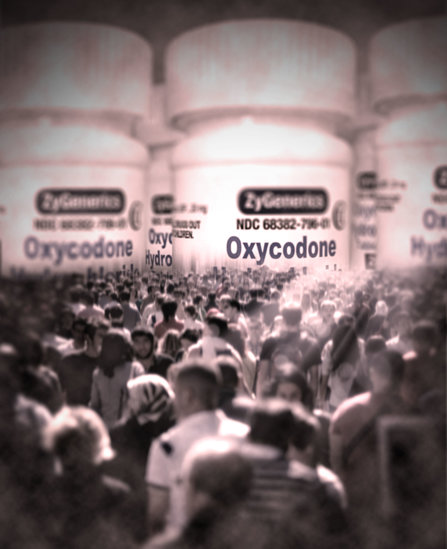Drug Makers Receive Patent for Drugs to Treat Addiction

In a recent news piece from CBS News, one of the top pharmaceutical companies for opioid pain reliever production, Purdue Pharmaceuticals, has now received a patent for making a drug that is advertised as being able to treat opioid addiction. This patent is for a new and improved, faster-acting form of buprenorphine, aka Suboxone.
Buprenorphine is a medicine which controls drug cravings, acting as a substitute medicine for patients who are addicted to opioid painkillers or heroin. Buprenorphine has been available for many years in the form of tablets or strips, but the new patent will allow for a “wafer” form of buprenorphine which can dissolve in the mouth and enter the bloodstream in just seconds.
But all of this begs the question, do we really need another opioid-based drug in our lives? Does the solution to the American opioid epidemic really lie in more remedial and substitute drugs? Probably not.
How can a Drug “Treat” Addiction?
Herein we find the basic misconception behind drugs like buprenorphine, methadone, and anything else that falls under the category of “Medication-Assisted Treatments.” Supporters of such treatments insist that substitute drugs are often necessary, as some addicts become so heavily addicted to their drugs that they can’t manage their condition without a substitute drug.
So how then can a drug treat addiction to other drugs? The truth is, it can’t. As long as a recovering addict is relying on a substitute drug just to get by, they’ve really only swapped one addiction for another, and they’re not really getting clean.
What is Buprenorphine/Suboxone?

What exactly is buprenorphine? The National Alliance of Advocates for Buprenorphine defines it by saying that buprenorphine is itself an "opioid medication used to treat opioid addiction." The Advocates go on to describe buprenorphine as being a “partial opioid agonist,” which means that it does not have the full potential of effects that regular opioids like heroin and painkillers do.
The NAAB insists that buprenorphine creates less euphoria and less physical dependence than full opioid agonists do and that there is a ceiling to the effects that buprenorphine has on the patient. Essentially, the NAAB insist that, because buprenorphine is not a full opioid, that it is ideally suited for helping opioid addicts come down off of opioids while still receiving the physical benefits of opioid pain relievers.
The problem is, is one really free from addiction if they still have to take a drug that is, itself, potentially addictive?
Why Buprenorphine is Not a Solution to Addiction
The National Pain Report put together a piece on buprenorphine, interviewing key experts and gathering research data from the Substance Abuse and Mental Health Services Administration. According to the report, while buprenorphine may have been invented with good intentions originally, it is not used ethically anymore, if it ever was.
In addition, the report pointed out that many addicts use buprenorphine/Suboxone as a segue drug, a way to bridge the gap from one high to the next. Buprenorphine is not as euphoric or potent as painkillers or heroin are, but it will ward off withdrawal symptoms and keep an addict at a mellow, relaxed point while they search for other drugs to use.
According to Percy Menzies, a pharmacist and addiction expert who spoke in the same article in National Pain Report, “This is insanity. Buprenorphine is one of the most abused pharmaceuticals in the world. We took an abused drug and we said let’s use it to treat addiction to heroin and opiates. It’s a perfect formula for drug addiction. Suboxone, in my estimation, has allowed a very significant number of people to maintain their addiction.”
And Charlie Cichon was interviewed for the article as well. Charlie is the executive director of the National Association of Drug Diversion Investigators. He said, “This was a great drug for its intended use. But the abusers found out that this was another drug that they liked. It’s not a drug that gets them on that high plain like the other drugs that they abuse. But if they can’t get the drug that they like, Suboxone is readily available and it keeps them at this mellow stage until they can get the next drug.”
According to the Substance Abuse and Mental Health Services Administration, emergency room visits involving buprenorphine increased from about three thousand visits in 2005 to more than thirty thousand visits just five years later in 2010. More than half of these visits were recorded as being caused by the non-medical use of buprenorphine to get high.
So clearly, the first reason why buprenorphine is not appropriate as a tool for addressing addiction is that buprenorphine itself has a risk for inspiring misuse in those who take it.
The Severity of the Opioid Crisis and Why We Need Real Solutions Through Treatment
Buprenorphine is not the answer to the opioid epidemic that our nation is faced with. And the more we come to terms with that fact, the better off we will be. It is time that we get bare knuckles with the opioid crisis, and it is time that we forced ourselves to confront this problem in such a way that will fully address it.

How do we do this? How do we tackle an opioid crisis that has more than two million Americans fully addicted and eleven million more who have recreationally misused opioids? The U.S. Department of Health and Human Services reported that one-hundred and thirty people die every day from opioid-related accidents and overdoses. Clearly, this is a big problem.
The way to address the drug problem is to get people off of drugs. At the risk of sounding sarcastic, freedom from drug addiction actually does not involve getting on more drugs! Freedom from drug addiction involves getting off of the drugs that one is currently on. That’s the way out of the crisis.
There are millions of Americans who are chronically addicted to opioids or who misuse them recreationally. Every one of these individuals needs help and support in getting off of their respective drug problems. And the way to do that is with the help of inpatient addiction treatment centers.
Not only is buprenorphine addictive on its own, but it does not help those who take it to get to the bottom of what caused them to become addicts in the first place. Addiction is at least just as much a behavioral, mental, spiritual, and personal problem as it is a physical one. Buprenorphine does not address the full picture of addiction, hence its unworkability as a “treatment method.”
From a treatment perspective, using buprenorphine as a treatment method is much like wearing a helmet while riding a motorcycle at 200mph. Yes, the helmet might offer a small sense of security, but that doesn’t change the fact that you are still doing something extremely dangerous. And at speeds that great, will the helmet save your life? Unlikely.
Inpatient addiction treatment centers, on the other hand, do address the multi-faceted crisis that is an addiction. With inpatient rehabilitation centers, people are able to overcome even the most devastating of physical and mental addiction problems. Inpatient rehabilitation programs and their multi-faceted approaches to one’s addiction crisis are the answer to a drug habit, not another drug.
Sources:
- https://www.cbsnews.com/news/oxycontin-maker-receives-patent-for-drug-to-treat-opioid-addiction/
- https://www.naabt.org/faq_answers.cfm
- http://nationalpainreport.com/suboxone-new-drug-epidemic-8821747.html
- https://www.samhsa.gov/data/sites/default/files/DAWN106/DAWN106/sr106-buprenorphine.htm
- https://www.hhs.gov/opioids/about-the-epidemic/index.html


 ®
®